Reflective Essay on Contemporary Leadership Theories and Practices
VerifiedAdded on 2021/05/31
|12
|3014
|217
Essay
AI Summary
This reflective essay examines contemporary leadership from various perspectives, discussing the significance of appropriate leadership styles in different contexts. It explores diverse leadership theories, including trait, behavioral, and transformational leadership, emphasizing the qualities of successful leaders, such as intelligence, integrity, and motivational skills. The essay analyzes the application of these theories in modern business environments, highlighting the importance of leaders maintaining diversity and motivating their teams. Furthermore, it identifies personal weaknesses and outlines a personal development plan to enhance leadership aptitude. The paper also delves into effective leadership styles, emphasizing the art of motivating and influencing individuals to achieve common goals, and concludes with a discussion on the characteristics of a good leader, including compassion, communication skills, and the ability to foster employee growth and development. The essay also discusses the importance of self-assessment, industry knowledge, and technology proficiency for leaders.
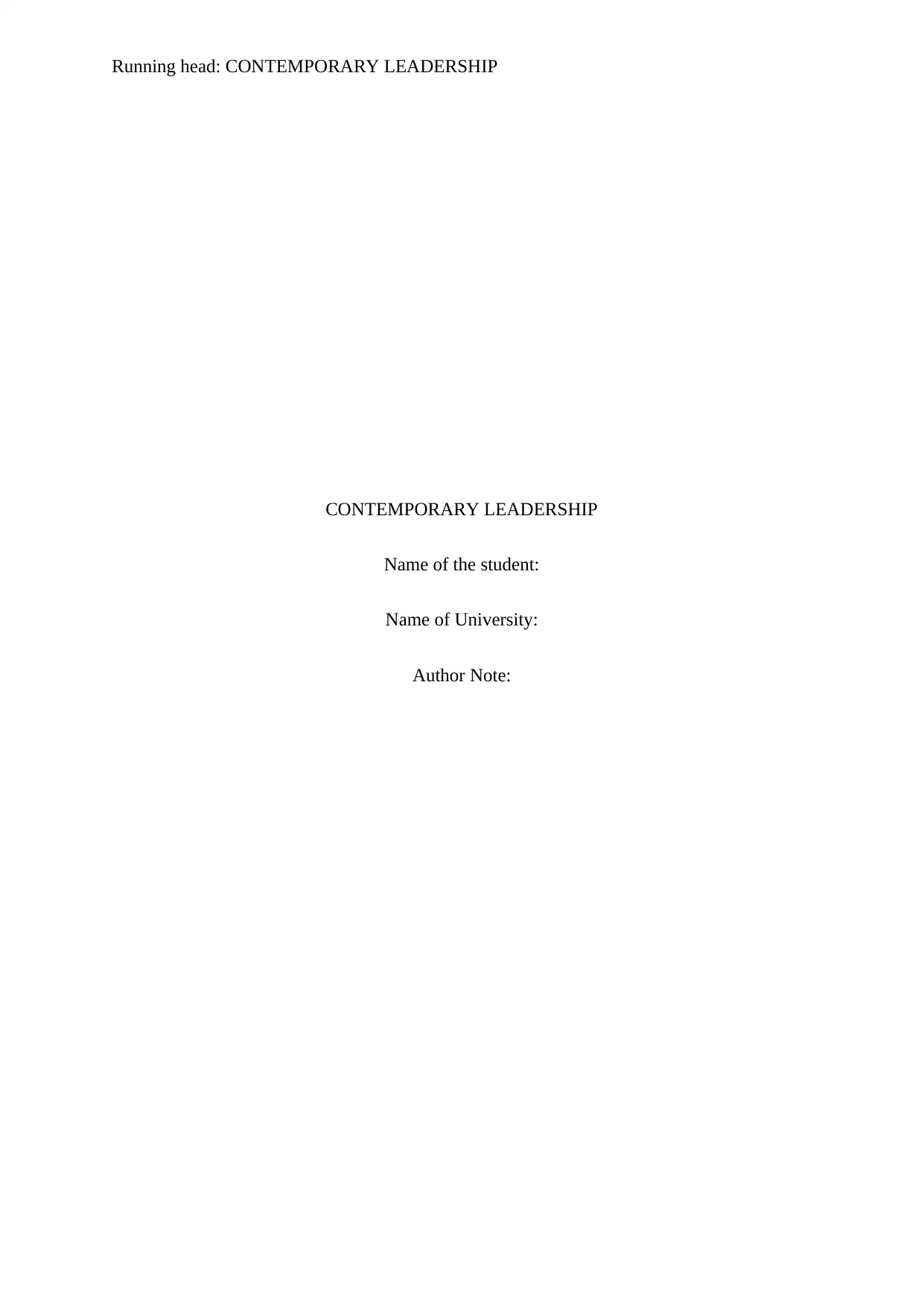
Running head: CONTEMPORARY LEADERSHIP
CONTEMPORARY LEADERSHIP
Name of the student:
Name of University:
Author Note:
CONTEMPORARY LEADERSHIP
Name of the student:
Name of University:
Author Note:
Paraphrase This Document
Need a fresh take? Get an instant paraphrase of this document with our AI Paraphraser
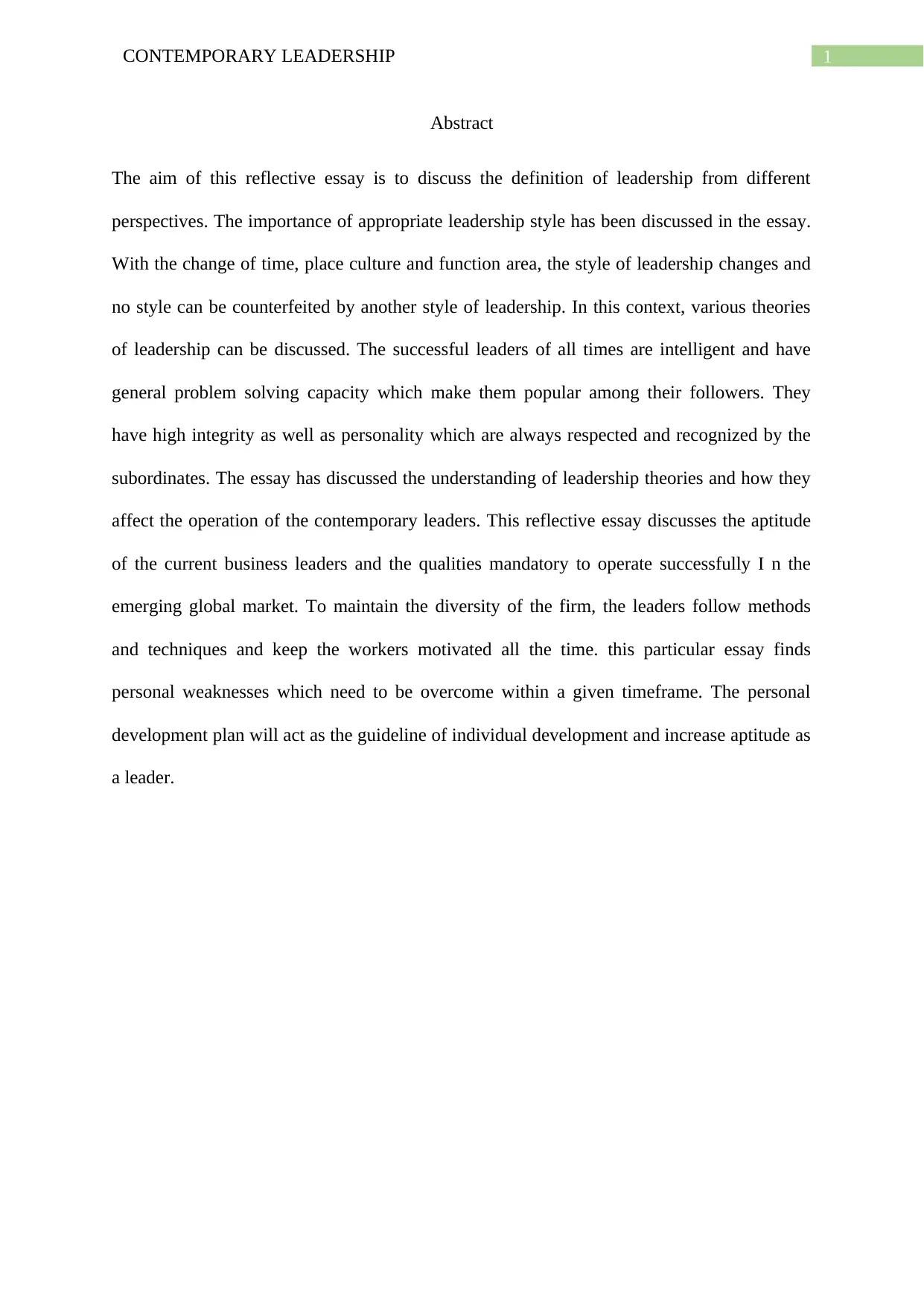
1CONTEMPORARY LEADERSHIP
Abstract
The aim of this reflective essay is to discuss the definition of leadership from different
perspectives. The importance of appropriate leadership style has been discussed in the essay.
With the change of time, place culture and function area, the style of leadership changes and
no style can be counterfeited by another style of leadership. In this context, various theories
of leadership can be discussed. The successful leaders of all times are intelligent and have
general problem solving capacity which make them popular among their followers. They
have high integrity as well as personality which are always respected and recognized by the
subordinates. The essay has discussed the understanding of leadership theories and how they
affect the operation of the contemporary leaders. This reflective essay discusses the aptitude
of the current business leaders and the qualities mandatory to operate successfully I n the
emerging global market. To maintain the diversity of the firm, the leaders follow methods
and techniques and keep the workers motivated all the time. this particular essay finds
personal weaknesses which need to be overcome within a given timeframe. The personal
development plan will act as the guideline of individual development and increase aptitude as
a leader.
Abstract
The aim of this reflective essay is to discuss the definition of leadership from different
perspectives. The importance of appropriate leadership style has been discussed in the essay.
With the change of time, place culture and function area, the style of leadership changes and
no style can be counterfeited by another style of leadership. In this context, various theories
of leadership can be discussed. The successful leaders of all times are intelligent and have
general problem solving capacity which make them popular among their followers. They
have high integrity as well as personality which are always respected and recognized by the
subordinates. The essay has discussed the understanding of leadership theories and how they
affect the operation of the contemporary leaders. This reflective essay discusses the aptitude
of the current business leaders and the qualities mandatory to operate successfully I n the
emerging global market. To maintain the diversity of the firm, the leaders follow methods
and techniques and keep the workers motivated all the time. this particular essay finds
personal weaknesses which need to be overcome within a given timeframe. The personal
development plan will act as the guideline of individual development and increase aptitude as
a leader.
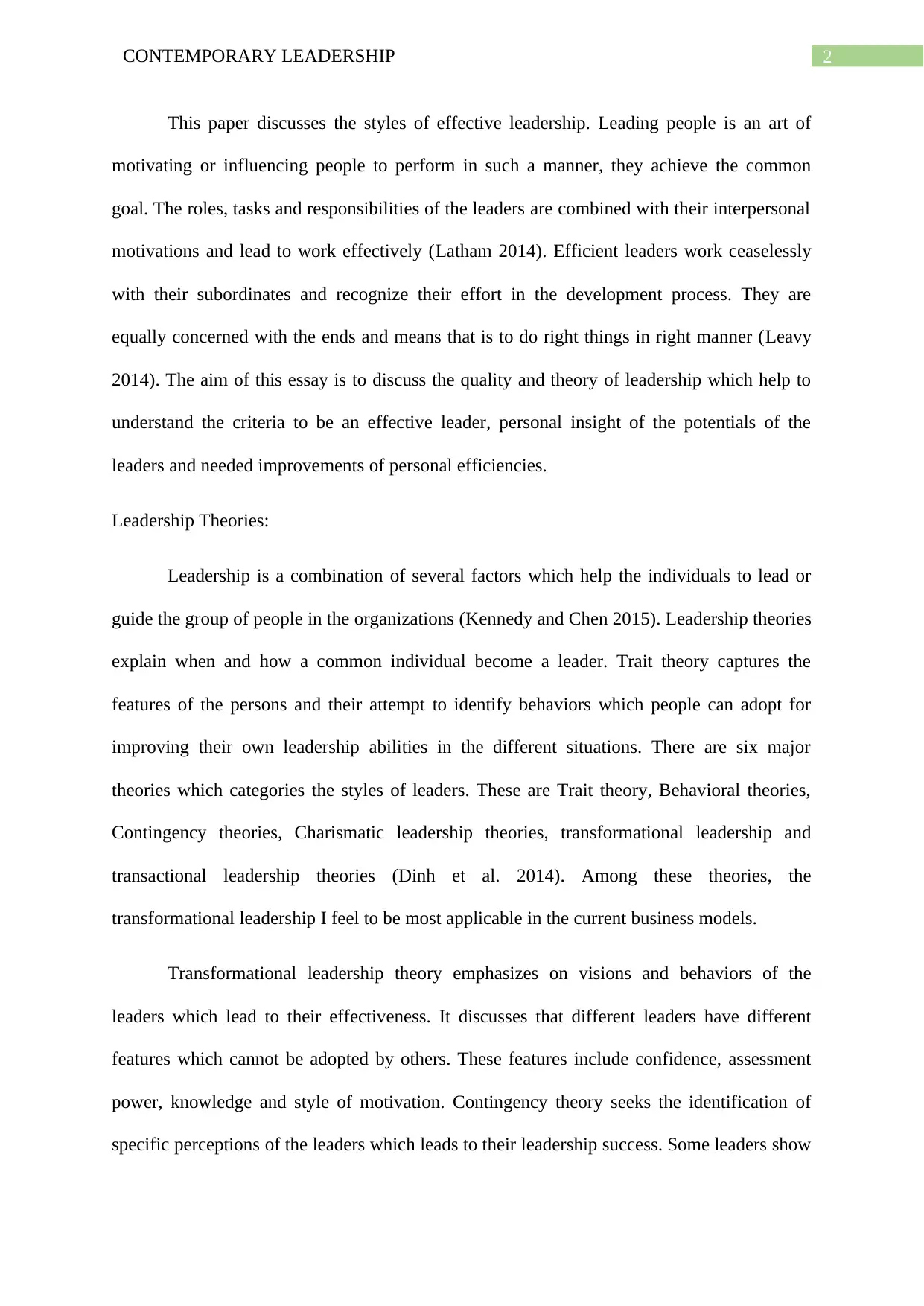
2CONTEMPORARY LEADERSHIP
This paper discusses the styles of effective leadership. Leading people is an art of
motivating or influencing people to perform in such a manner, they achieve the common
goal. The roles, tasks and responsibilities of the leaders are combined with their interpersonal
motivations and lead to work effectively (Latham 2014). Efficient leaders work ceaselessly
with their subordinates and recognize their effort in the development process. They are
equally concerned with the ends and means that is to do right things in right manner (Leavy
2014). The aim of this essay is to discuss the quality and theory of leadership which help to
understand the criteria to be an effective leader, personal insight of the potentials of the
leaders and needed improvements of personal efficiencies.
Leadership Theories:
Leadership is a combination of several factors which help the individuals to lead or
guide the group of people in the organizations (Kennedy and Chen 2015). Leadership theories
explain when and how a common individual become a leader. Trait theory captures the
features of the persons and their attempt to identify behaviors which people can adopt for
improving their own leadership abilities in the different situations. There are six major
theories which categories the styles of leaders. These are Trait theory, Behavioral theories,
Contingency theories, Charismatic leadership theories, transformational leadership and
transactional leadership theories (Dinh et al. 2014). Among these theories, the
transformational leadership I feel to be most applicable in the current business models.
Transformational leadership theory emphasizes on visions and behaviors of the
leaders which lead to their effectiveness. It discusses that different leaders have different
features which cannot be adopted by others. These features include confidence, assessment
power, knowledge and style of motivation. Contingency theory seeks the identification of
specific perceptions of the leaders which leads to their leadership success. Some leaders show
This paper discusses the styles of effective leadership. Leading people is an art of
motivating or influencing people to perform in such a manner, they achieve the common
goal. The roles, tasks and responsibilities of the leaders are combined with their interpersonal
motivations and lead to work effectively (Latham 2014). Efficient leaders work ceaselessly
with their subordinates and recognize their effort in the development process. They are
equally concerned with the ends and means that is to do right things in right manner (Leavy
2014). The aim of this essay is to discuss the quality and theory of leadership which help to
understand the criteria to be an effective leader, personal insight of the potentials of the
leaders and needed improvements of personal efficiencies.
Leadership Theories:
Leadership is a combination of several factors which help the individuals to lead or
guide the group of people in the organizations (Kennedy and Chen 2015). Leadership theories
explain when and how a common individual become a leader. Trait theory captures the
features of the persons and their attempt to identify behaviors which people can adopt for
improving their own leadership abilities in the different situations. There are six major
theories which categories the styles of leaders. These are Trait theory, Behavioral theories,
Contingency theories, Charismatic leadership theories, transformational leadership and
transactional leadership theories (Dinh et al. 2014). Among these theories, the
transformational leadership I feel to be most applicable in the current business models.
Transformational leadership theory emphasizes on visions and behaviors of the
leaders which lead to their effectiveness. It discusses that different leaders have different
features which cannot be adopted by others. These features include confidence, assessment
power, knowledge and style of motivation. Contingency theory seeks the identification of
specific perceptions of the leaders which leads to their leadership success. Some leaders show
⊘ This is a preview!⊘
Do you want full access?
Subscribe today to unlock all pages.

Trusted by 1+ million students worldwide
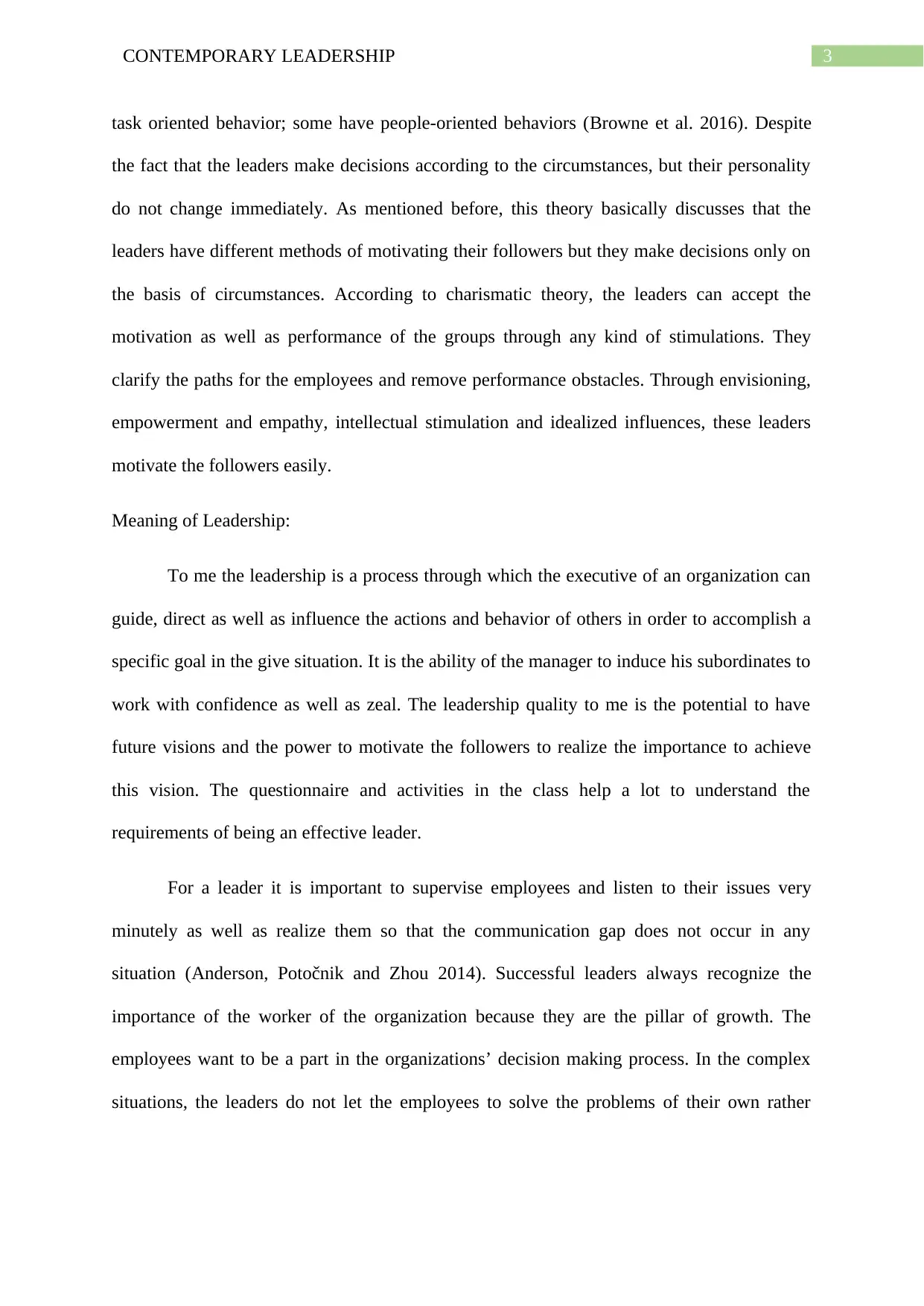
3CONTEMPORARY LEADERSHIP
task oriented behavior; some have people-oriented behaviors (Browne et al. 2016). Despite
the fact that the leaders make decisions according to the circumstances, but their personality
do not change immediately. As mentioned before, this theory basically discusses that the
leaders have different methods of motivating their followers but they make decisions only on
the basis of circumstances. According to charismatic theory, the leaders can accept the
motivation as well as performance of the groups through any kind of stimulations. They
clarify the paths for the employees and remove performance obstacles. Through envisioning,
empowerment and empathy, intellectual stimulation and idealized influences, these leaders
motivate the followers easily.
Meaning of Leadership:
To me the leadership is a process through which the executive of an organization can
guide, direct as well as influence the actions and behavior of others in order to accomplish a
specific goal in the give situation. It is the ability of the manager to induce his subordinates to
work with confidence as well as zeal. The leadership quality to me is the potential to have
future visions and the power to motivate the followers to realize the importance to achieve
this vision. The questionnaire and activities in the class help a lot to understand the
requirements of being an effective leader.
For a leader it is important to supervise employees and listen to their issues very
minutely as well as realize them so that the communication gap does not occur in any
situation (Anderson, Potočnik and Zhou 2014). Successful leaders always recognize the
importance of the worker of the organization because they are the pillar of growth. The
employees want to be a part in the organizations’ decision making process. In the complex
situations, the leaders do not let the employees to solve the problems of their own rather
task oriented behavior; some have people-oriented behaviors (Browne et al. 2016). Despite
the fact that the leaders make decisions according to the circumstances, but their personality
do not change immediately. As mentioned before, this theory basically discusses that the
leaders have different methods of motivating their followers but they make decisions only on
the basis of circumstances. According to charismatic theory, the leaders can accept the
motivation as well as performance of the groups through any kind of stimulations. They
clarify the paths for the employees and remove performance obstacles. Through envisioning,
empowerment and empathy, intellectual stimulation and idealized influences, these leaders
motivate the followers easily.
Meaning of Leadership:
To me the leadership is a process through which the executive of an organization can
guide, direct as well as influence the actions and behavior of others in order to accomplish a
specific goal in the give situation. It is the ability of the manager to induce his subordinates to
work with confidence as well as zeal. The leadership quality to me is the potential to have
future visions and the power to motivate the followers to realize the importance to achieve
this vision. The questionnaire and activities in the class help a lot to understand the
requirements of being an effective leader.
For a leader it is important to supervise employees and listen to their issues very
minutely as well as realize them so that the communication gap does not occur in any
situation (Anderson, Potočnik and Zhou 2014). Successful leaders always recognize the
importance of the worker of the organization because they are the pillar of growth. The
employees want to be a part in the organizations’ decision making process. In the complex
situations, the leaders do not let the employees to solve the problems of their own rather
Paraphrase This Document
Need a fresh take? Get an instant paraphrase of this document with our AI Paraphraser
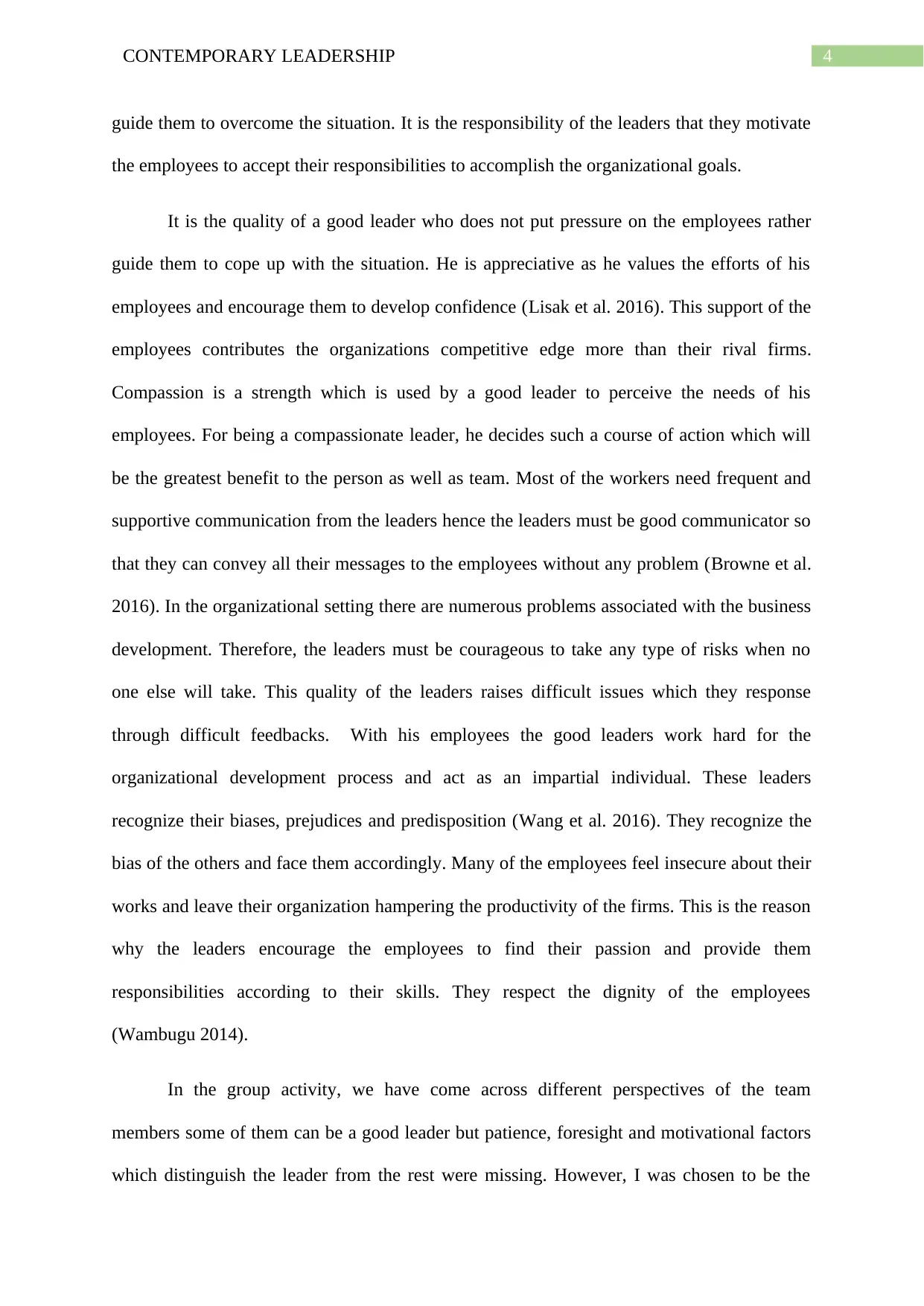
4CONTEMPORARY LEADERSHIP
guide them to overcome the situation. It is the responsibility of the leaders that they motivate
the employees to accept their responsibilities to accomplish the organizational goals.
It is the quality of a good leader who does not put pressure on the employees rather
guide them to cope up with the situation. He is appreciative as he values the efforts of his
employees and encourage them to develop confidence (Lisak et al. 2016). This support of the
employees contributes the organizations competitive edge more than their rival firms.
Compassion is a strength which is used by a good leader to perceive the needs of his
employees. For being a compassionate leader, he decides such a course of action which will
be the greatest benefit to the person as well as team. Most of the workers need frequent and
supportive communication from the leaders hence the leaders must be good communicator so
that they can convey all their messages to the employees without any problem (Browne et al.
2016). In the organizational setting there are numerous problems associated with the business
development. Therefore, the leaders must be courageous to take any type of risks when no
one else will take. This quality of the leaders raises difficult issues which they response
through difficult feedbacks. With his employees the good leaders work hard for the
organizational development process and act as an impartial individual. These leaders
recognize their biases, prejudices and predisposition (Wang et al. 2016). They recognize the
bias of the others and face them accordingly. Many of the employees feel insecure about their
works and leave their organization hampering the productivity of the firms. This is the reason
why the leaders encourage the employees to find their passion and provide them
responsibilities according to their skills. They respect the dignity of the employees
(Wambugu 2014).
In the group activity, we have come across different perspectives of the team
members some of them can be a good leader but patience, foresight and motivational factors
which distinguish the leader from the rest were missing. However, I was chosen to be the
guide them to overcome the situation. It is the responsibility of the leaders that they motivate
the employees to accept their responsibilities to accomplish the organizational goals.
It is the quality of a good leader who does not put pressure on the employees rather
guide them to cope up with the situation. He is appreciative as he values the efforts of his
employees and encourage them to develop confidence (Lisak et al. 2016). This support of the
employees contributes the organizations competitive edge more than their rival firms.
Compassion is a strength which is used by a good leader to perceive the needs of his
employees. For being a compassionate leader, he decides such a course of action which will
be the greatest benefit to the person as well as team. Most of the workers need frequent and
supportive communication from the leaders hence the leaders must be good communicator so
that they can convey all their messages to the employees without any problem (Browne et al.
2016). In the organizational setting there are numerous problems associated with the business
development. Therefore, the leaders must be courageous to take any type of risks when no
one else will take. This quality of the leaders raises difficult issues which they response
through difficult feedbacks. With his employees the good leaders work hard for the
organizational development process and act as an impartial individual. These leaders
recognize their biases, prejudices and predisposition (Wang et al. 2016). They recognize the
bias of the others and face them accordingly. Many of the employees feel insecure about their
works and leave their organization hampering the productivity of the firms. This is the reason
why the leaders encourage the employees to find their passion and provide them
responsibilities according to their skills. They respect the dignity of the employees
(Wambugu 2014).
In the group activity, we have come across different perspectives of the team
members some of them can be a good leader but patience, foresight and motivational factors
which distinguish the leader from the rest were missing. However, I was chosen to be the
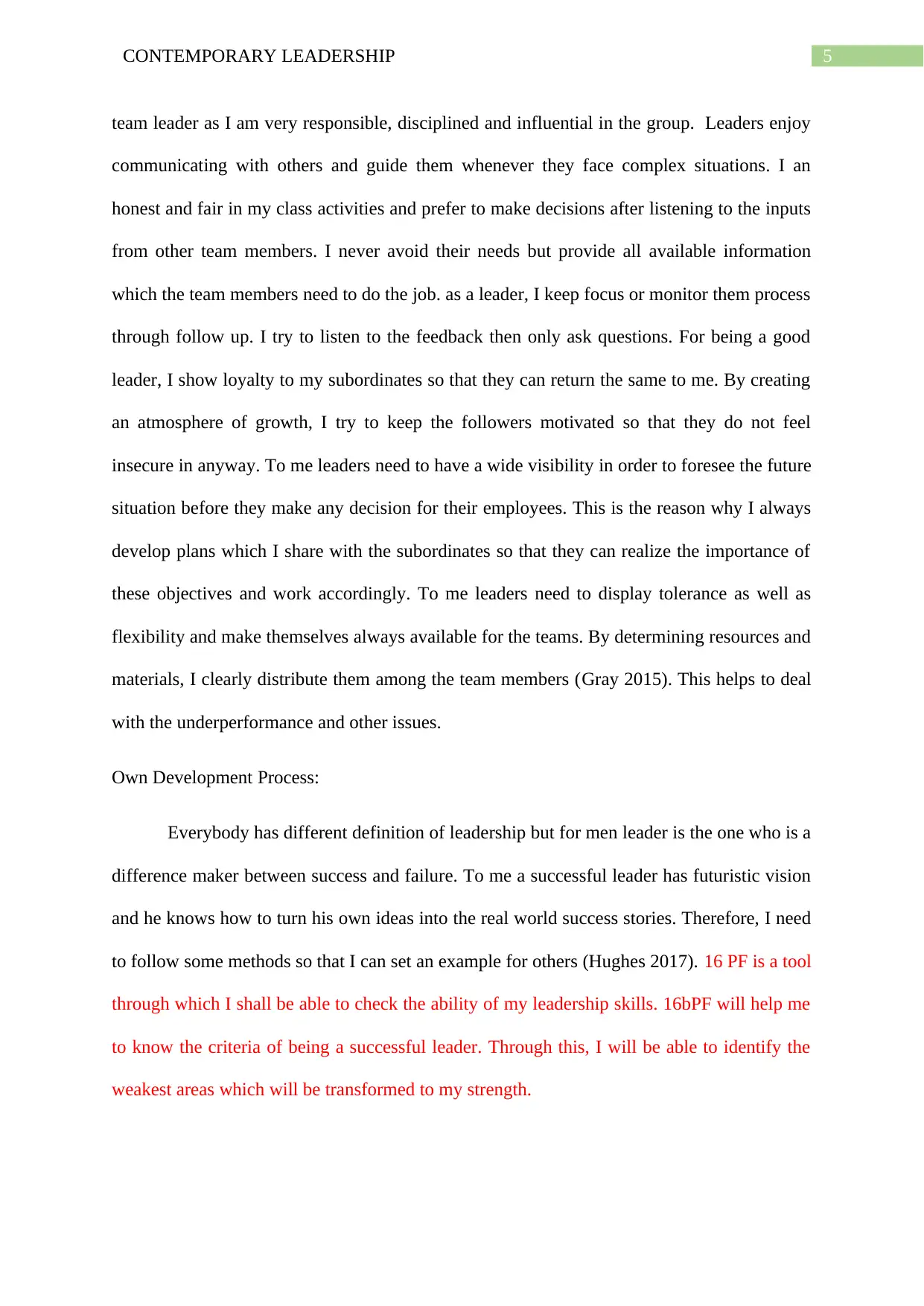
5CONTEMPORARY LEADERSHIP
team leader as I am very responsible, disciplined and influential in the group. Leaders enjoy
communicating with others and guide them whenever they face complex situations. I an
honest and fair in my class activities and prefer to make decisions after listening to the inputs
from other team members. I never avoid their needs but provide all available information
which the team members need to do the job. as a leader, I keep focus or monitor them process
through follow up. I try to listen to the feedback then only ask questions. For being a good
leader, I show loyalty to my subordinates so that they can return the same to me. By creating
an atmosphere of growth, I try to keep the followers motivated so that they do not feel
insecure in anyway. To me leaders need to have a wide visibility in order to foresee the future
situation before they make any decision for their employees. This is the reason why I always
develop plans which I share with the subordinates so that they can realize the importance of
these objectives and work accordingly. To me leaders need to display tolerance as well as
flexibility and make themselves always available for the teams. By determining resources and
materials, I clearly distribute them among the team members (Gray 2015). This helps to deal
with the underperformance and other issues.
Own Development Process:
Everybody has different definition of leadership but for men leader is the one who is a
difference maker between success and failure. To me a successful leader has futuristic vision
and he knows how to turn his own ideas into the real world success stories. Therefore, I need
to follow some methods so that I can set an example for others (Hughes 2017). 16 PF is a tool
through which I shall be able to check the ability of my leadership skills. 16bPF will help me
to know the criteria of being a successful leader. Through this, I will be able to identify the
weakest areas which will be transformed to my strength.
team leader as I am very responsible, disciplined and influential in the group. Leaders enjoy
communicating with others and guide them whenever they face complex situations. I an
honest and fair in my class activities and prefer to make decisions after listening to the inputs
from other team members. I never avoid their needs but provide all available information
which the team members need to do the job. as a leader, I keep focus or monitor them process
through follow up. I try to listen to the feedback then only ask questions. For being a good
leader, I show loyalty to my subordinates so that they can return the same to me. By creating
an atmosphere of growth, I try to keep the followers motivated so that they do not feel
insecure in anyway. To me leaders need to have a wide visibility in order to foresee the future
situation before they make any decision for their employees. This is the reason why I always
develop plans which I share with the subordinates so that they can realize the importance of
these objectives and work accordingly. To me leaders need to display tolerance as well as
flexibility and make themselves always available for the teams. By determining resources and
materials, I clearly distribute them among the team members (Gray 2015). This helps to deal
with the underperformance and other issues.
Own Development Process:
Everybody has different definition of leadership but for men leader is the one who is a
difference maker between success and failure. To me a successful leader has futuristic vision
and he knows how to turn his own ideas into the real world success stories. Therefore, I need
to follow some methods so that I can set an example for others (Hughes 2017). 16 PF is a tool
through which I shall be able to check the ability of my leadership skills. 16bPF will help me
to know the criteria of being a successful leader. Through this, I will be able to identify the
weakest areas which will be transformed to my strength.
⊘ This is a preview!⊘
Do you want full access?
Subscribe today to unlock all pages.

Trusted by 1+ million students worldwide
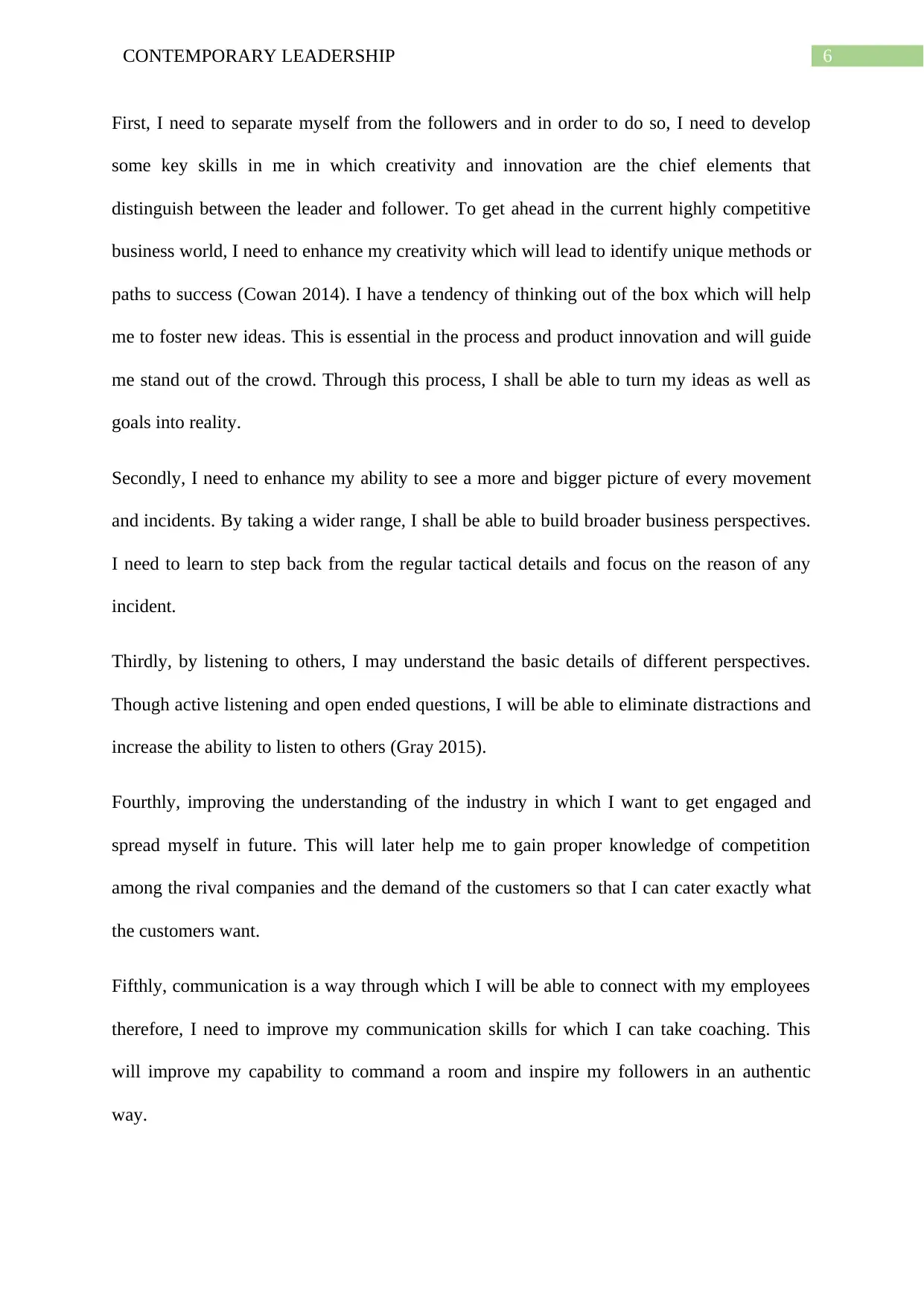
6CONTEMPORARY LEADERSHIP
First, I need to separate myself from the followers and in order to do so, I need to develop
some key skills in me in which creativity and innovation are the chief elements that
distinguish between the leader and follower. To get ahead in the current highly competitive
business world, I need to enhance my creativity which will lead to identify unique methods or
paths to success (Cowan 2014). I have a tendency of thinking out of the box which will help
me to foster new ideas. This is essential in the process and product innovation and will guide
me stand out of the crowd. Through this process, I shall be able to turn my ideas as well as
goals into reality.
Secondly, I need to enhance my ability to see a more and bigger picture of every movement
and incidents. By taking a wider range, I shall be able to build broader business perspectives.
I need to learn to step back from the regular tactical details and focus on the reason of any
incident.
Thirdly, by listening to others, I may understand the basic details of different perspectives.
Though active listening and open ended questions, I will be able to eliminate distractions and
increase the ability to listen to others (Gray 2015).
Fourthly, improving the understanding of the industry in which I want to get engaged and
spread myself in future. This will later help me to gain proper knowledge of competition
among the rival companies and the demand of the customers so that I can cater exactly what
the customers want.
Fifthly, communication is a way through which I will be able to connect with my employees
therefore, I need to improve my communication skills for which I can take coaching. This
will improve my capability to command a room and inspire my followers in an authentic
way.
First, I need to separate myself from the followers and in order to do so, I need to develop
some key skills in me in which creativity and innovation are the chief elements that
distinguish between the leader and follower. To get ahead in the current highly competitive
business world, I need to enhance my creativity which will lead to identify unique methods or
paths to success (Cowan 2014). I have a tendency of thinking out of the box which will help
me to foster new ideas. This is essential in the process and product innovation and will guide
me stand out of the crowd. Through this process, I shall be able to turn my ideas as well as
goals into reality.
Secondly, I need to enhance my ability to see a more and bigger picture of every movement
and incidents. By taking a wider range, I shall be able to build broader business perspectives.
I need to learn to step back from the regular tactical details and focus on the reason of any
incident.
Thirdly, by listening to others, I may understand the basic details of different perspectives.
Though active listening and open ended questions, I will be able to eliminate distractions and
increase the ability to listen to others (Gray 2015).
Fourthly, improving the understanding of the industry in which I want to get engaged and
spread myself in future. This will later help me to gain proper knowledge of competition
among the rival companies and the demand of the customers so that I can cater exactly what
the customers want.
Fifthly, communication is a way through which I will be able to connect with my employees
therefore, I need to improve my communication skills for which I can take coaching. This
will improve my capability to command a room and inspire my followers in an authentic
way.
Paraphrase This Document
Need a fresh take? Get an instant paraphrase of this document with our AI Paraphraser
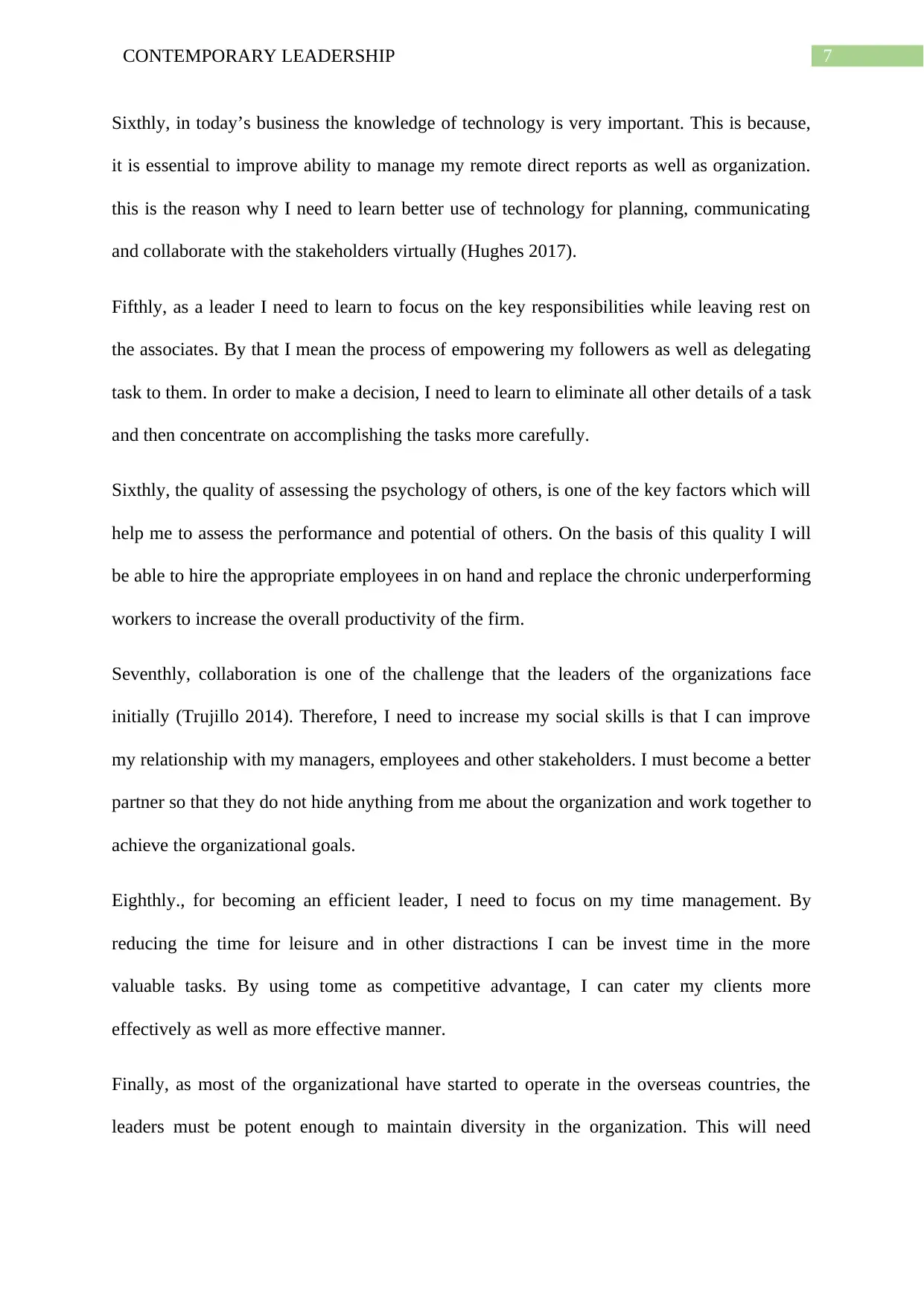
7CONTEMPORARY LEADERSHIP
Sixthly, in today’s business the knowledge of technology is very important. This is because,
it is essential to improve ability to manage my remote direct reports as well as organization.
this is the reason why I need to learn better use of technology for planning, communicating
and collaborate with the stakeholders virtually (Hughes 2017).
Fifthly, as a leader I need to learn to focus on the key responsibilities while leaving rest on
the associates. By that I mean the process of empowering my followers as well as delegating
task to them. In order to make a decision, I need to learn to eliminate all other details of a task
and then concentrate on accomplishing the tasks more carefully.
Sixthly, the quality of assessing the psychology of others, is one of the key factors which will
help me to assess the performance and potential of others. On the basis of this quality I will
be able to hire the appropriate employees in on hand and replace the chronic underperforming
workers to increase the overall productivity of the firm.
Seventhly, collaboration is one of the challenge that the leaders of the organizations face
initially (Trujillo 2014). Therefore, I need to increase my social skills is that I can improve
my relationship with my managers, employees and other stakeholders. I must become a better
partner so that they do not hide anything from me about the organization and work together to
achieve the organizational goals.
Eighthly., for becoming an efficient leader, I need to focus on my time management. By
reducing the time for leisure and in other distractions I can be invest time in the more
valuable tasks. By using tome as competitive advantage, I can cater my clients more
effectively as well as more effective manner.
Finally, as most of the organizational have started to operate in the overseas countries, the
leaders must be potent enough to maintain diversity in the organization. This will need
Sixthly, in today’s business the knowledge of technology is very important. This is because,
it is essential to improve ability to manage my remote direct reports as well as organization.
this is the reason why I need to learn better use of technology for planning, communicating
and collaborate with the stakeholders virtually (Hughes 2017).
Fifthly, as a leader I need to learn to focus on the key responsibilities while leaving rest on
the associates. By that I mean the process of empowering my followers as well as delegating
task to them. In order to make a decision, I need to learn to eliminate all other details of a task
and then concentrate on accomplishing the tasks more carefully.
Sixthly, the quality of assessing the psychology of others, is one of the key factors which will
help me to assess the performance and potential of others. On the basis of this quality I will
be able to hire the appropriate employees in on hand and replace the chronic underperforming
workers to increase the overall productivity of the firm.
Seventhly, collaboration is one of the challenge that the leaders of the organizations face
initially (Trujillo 2014). Therefore, I need to increase my social skills is that I can improve
my relationship with my managers, employees and other stakeholders. I must become a better
partner so that they do not hide anything from me about the organization and work together to
achieve the organizational goals.
Eighthly., for becoming an efficient leader, I need to focus on my time management. By
reducing the time for leisure and in other distractions I can be invest time in the more
valuable tasks. By using tome as competitive advantage, I can cater my clients more
effectively as well as more effective manner.
Finally, as most of the organizational have started to operate in the overseas countries, the
leaders must be potent enough to maintain diversity in the organization. This will need
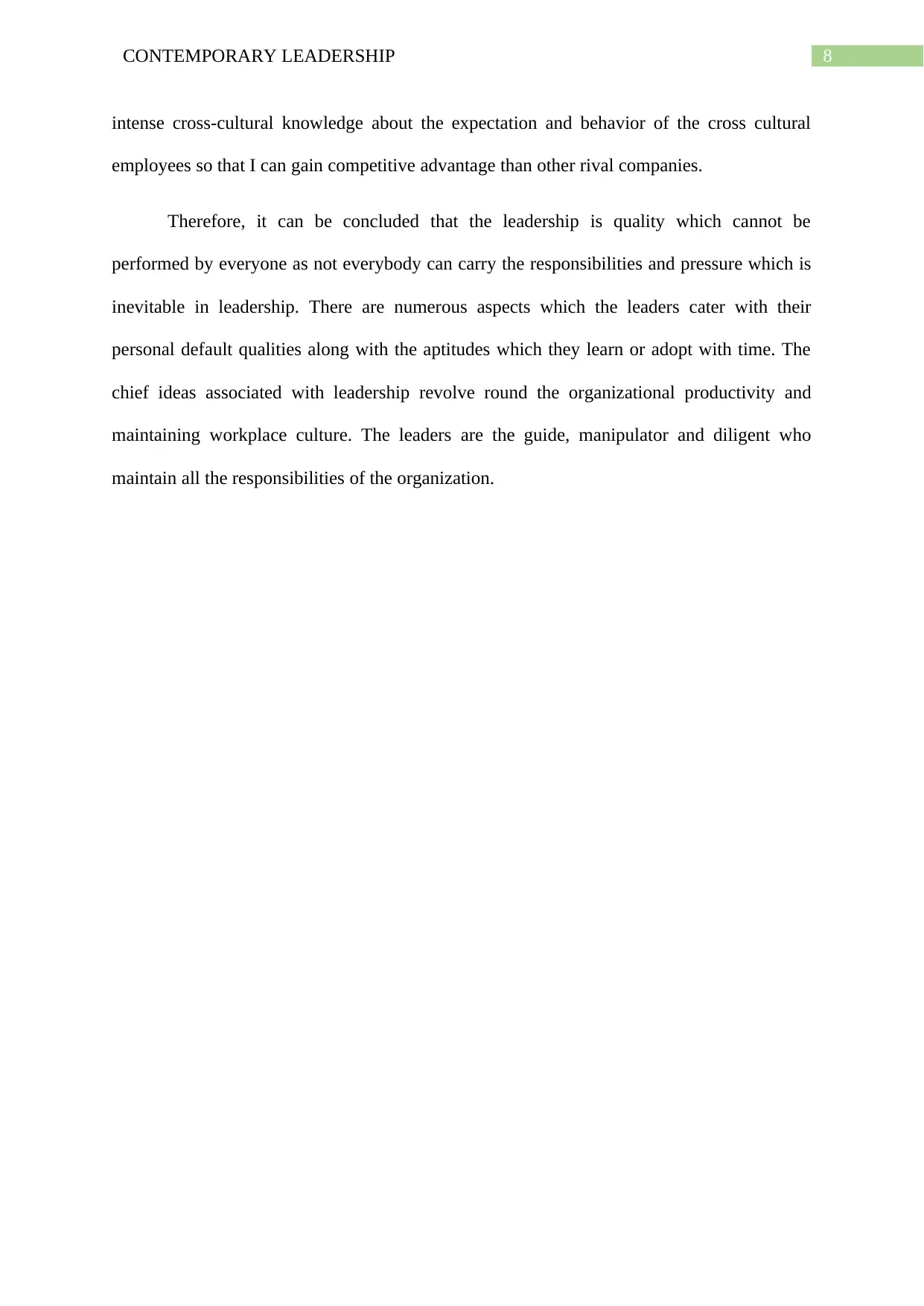
8CONTEMPORARY LEADERSHIP
intense cross-cultural knowledge about the expectation and behavior of the cross cultural
employees so that I can gain competitive advantage than other rival companies.
Therefore, it can be concluded that the leadership is quality which cannot be
performed by everyone as not everybody can carry the responsibilities and pressure which is
inevitable in leadership. There are numerous aspects which the leaders cater with their
personal default qualities along with the aptitudes which they learn or adopt with time. The
chief ideas associated with leadership revolve round the organizational productivity and
maintaining workplace culture. The leaders are the guide, manipulator and diligent who
maintain all the responsibilities of the organization.
intense cross-cultural knowledge about the expectation and behavior of the cross cultural
employees so that I can gain competitive advantage than other rival companies.
Therefore, it can be concluded that the leadership is quality which cannot be
performed by everyone as not everybody can carry the responsibilities and pressure which is
inevitable in leadership. There are numerous aspects which the leaders cater with their
personal default qualities along with the aptitudes which they learn or adopt with time. The
chief ideas associated with leadership revolve round the organizational productivity and
maintaining workplace culture. The leaders are the guide, manipulator and diligent who
maintain all the responsibilities of the organization.
⊘ This is a preview!⊘
Do you want full access?
Subscribe today to unlock all pages.

Trusted by 1+ million students worldwide
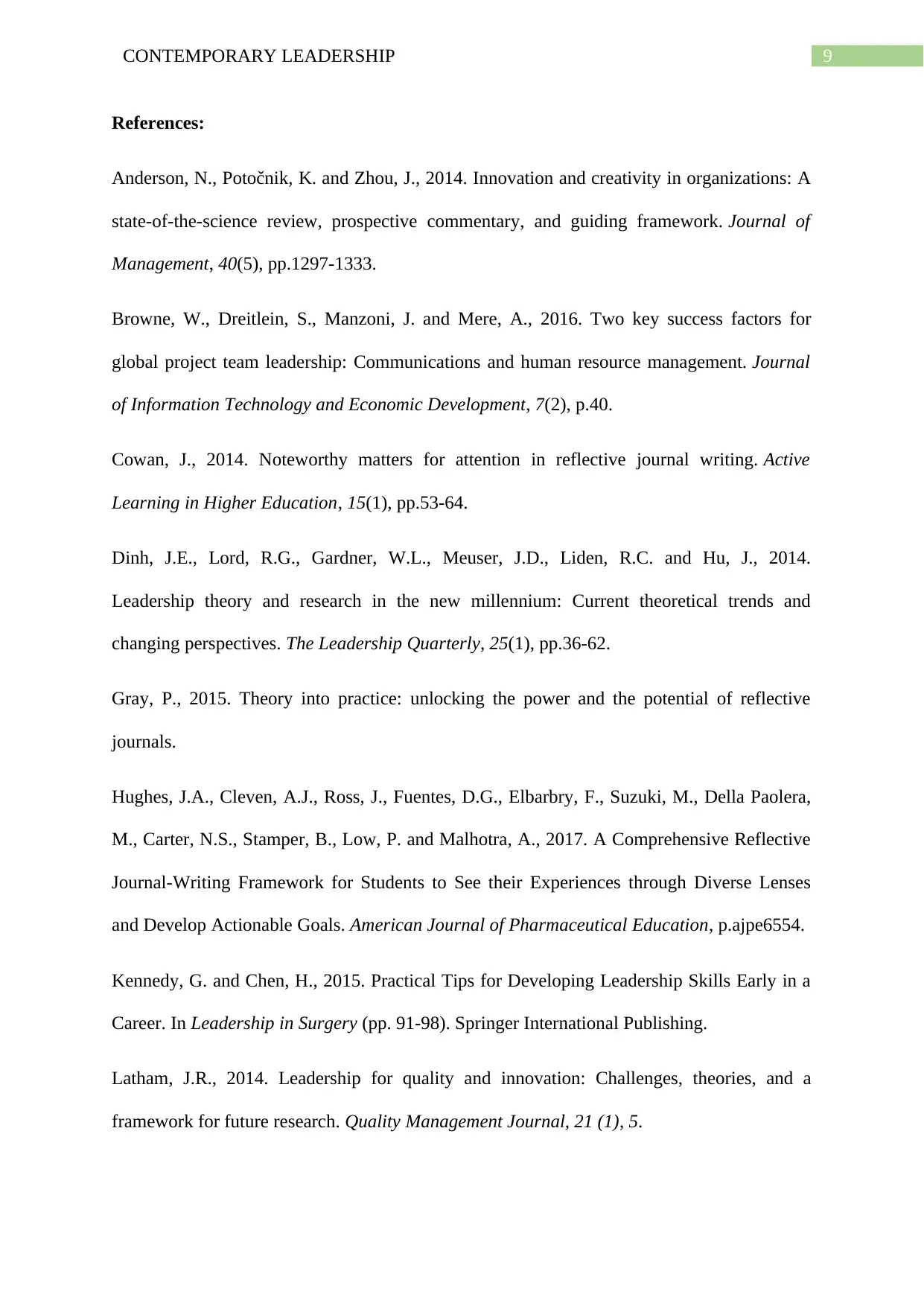
9CONTEMPORARY LEADERSHIP
References:
Anderson, N., Potočnik, K. and Zhou, J., 2014. Innovation and creativity in organizations: A
state-of-the-science review, prospective commentary, and guiding framework. Journal of
Management, 40(5), pp.1297-1333.
Browne, W., Dreitlein, S., Manzoni, J. and Mere, A., 2016. Two key success factors for
global project team leadership: Communications and human resource management. Journal
of Information Technology and Economic Development, 7(2), p.40.
Cowan, J., 2014. Noteworthy matters for attention in reflective journal writing. Active
Learning in Higher Education, 15(1), pp.53-64.
Dinh, J.E., Lord, R.G., Gardner, W.L., Meuser, J.D., Liden, R.C. and Hu, J., 2014.
Leadership theory and research in the new millennium: Current theoretical trends and
changing perspectives. The Leadership Quarterly, 25(1), pp.36-62.
Gray, P., 2015. Theory into practice: unlocking the power and the potential of reflective
journals.
Hughes, J.A., Cleven, A.J., Ross, J., Fuentes, D.G., Elbarbry, F., Suzuki, M., Della Paolera,
M., Carter, N.S., Stamper, B., Low, P. and Malhotra, A., 2017. A Comprehensive Reflective
Journal-Writing Framework for Students to See their Experiences through Diverse Lenses
and Develop Actionable Goals. American Journal of Pharmaceutical Education, p.ajpe6554.
Kennedy, G. and Chen, H., 2015. Practical Tips for Developing Leadership Skills Early in a
Career. In Leadership in Surgery (pp. 91-98). Springer International Publishing.
Latham, J.R., 2014. Leadership for quality and innovation: Challenges, theories, and a
framework for future research. Quality Management Journal, 21 (1), 5.
References:
Anderson, N., Potočnik, K. and Zhou, J., 2014. Innovation and creativity in organizations: A
state-of-the-science review, prospective commentary, and guiding framework. Journal of
Management, 40(5), pp.1297-1333.
Browne, W., Dreitlein, S., Manzoni, J. and Mere, A., 2016. Two key success factors for
global project team leadership: Communications and human resource management. Journal
of Information Technology and Economic Development, 7(2), p.40.
Cowan, J., 2014. Noteworthy matters for attention in reflective journal writing. Active
Learning in Higher Education, 15(1), pp.53-64.
Dinh, J.E., Lord, R.G., Gardner, W.L., Meuser, J.D., Liden, R.C. and Hu, J., 2014.
Leadership theory and research in the new millennium: Current theoretical trends and
changing perspectives. The Leadership Quarterly, 25(1), pp.36-62.
Gray, P., 2015. Theory into practice: unlocking the power and the potential of reflective
journals.
Hughes, J.A., Cleven, A.J., Ross, J., Fuentes, D.G., Elbarbry, F., Suzuki, M., Della Paolera,
M., Carter, N.S., Stamper, B., Low, P. and Malhotra, A., 2017. A Comprehensive Reflective
Journal-Writing Framework for Students to See their Experiences through Diverse Lenses
and Develop Actionable Goals. American Journal of Pharmaceutical Education, p.ajpe6554.
Kennedy, G. and Chen, H., 2015. Practical Tips for Developing Leadership Skills Early in a
Career. In Leadership in Surgery (pp. 91-98). Springer International Publishing.
Latham, J.R., 2014. Leadership for quality and innovation: Challenges, theories, and a
framework for future research. Quality Management Journal, 21 (1), 5.
Paraphrase This Document
Need a fresh take? Get an instant paraphrase of this document with our AI Paraphraser
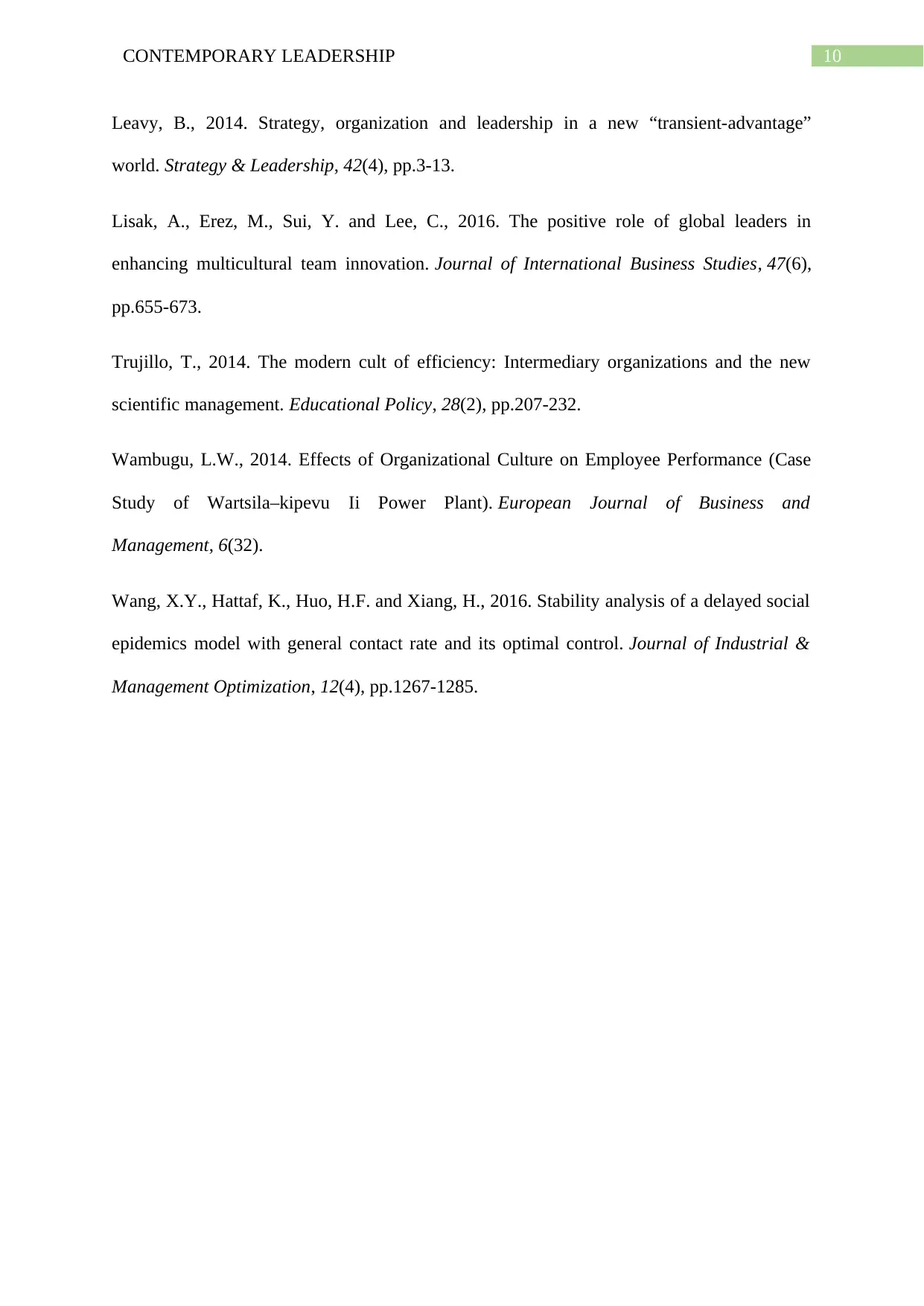
10CONTEMPORARY LEADERSHIP
Leavy, B., 2014. Strategy, organization and leadership in a new “transient-advantage”
world. Strategy & Leadership, 42(4), pp.3-13.
Lisak, A., Erez, M., Sui, Y. and Lee, C., 2016. The positive role of global leaders in
enhancing multicultural team innovation. Journal of International Business Studies, 47(6),
pp.655-673.
Trujillo, T., 2014. The modern cult of efficiency: Intermediary organizations and the new
scientific management. Educational Policy, 28(2), pp.207-232.
Wambugu, L.W., 2014. Effects of Organizational Culture on Employee Performance (Case
Study of Wartsila–kipevu Ii Power Plant). European Journal of Business and
Management, 6(32).
Wang, X.Y., Hattaf, K., Huo, H.F. and Xiang, H., 2016. Stability analysis of a delayed social
epidemics model with general contact rate and its optimal control. Journal of Industrial &
Management Optimization, 12(4), pp.1267-1285.
Leavy, B., 2014. Strategy, organization and leadership in a new “transient-advantage”
world. Strategy & Leadership, 42(4), pp.3-13.
Lisak, A., Erez, M., Sui, Y. and Lee, C., 2016. The positive role of global leaders in
enhancing multicultural team innovation. Journal of International Business Studies, 47(6),
pp.655-673.
Trujillo, T., 2014. The modern cult of efficiency: Intermediary organizations and the new
scientific management. Educational Policy, 28(2), pp.207-232.
Wambugu, L.W., 2014. Effects of Organizational Culture on Employee Performance (Case
Study of Wartsila–kipevu Ii Power Plant). European Journal of Business and
Management, 6(32).
Wang, X.Y., Hattaf, K., Huo, H.F. and Xiang, H., 2016. Stability analysis of a delayed social
epidemics model with general contact rate and its optimal control. Journal of Industrial &
Management Optimization, 12(4), pp.1267-1285.
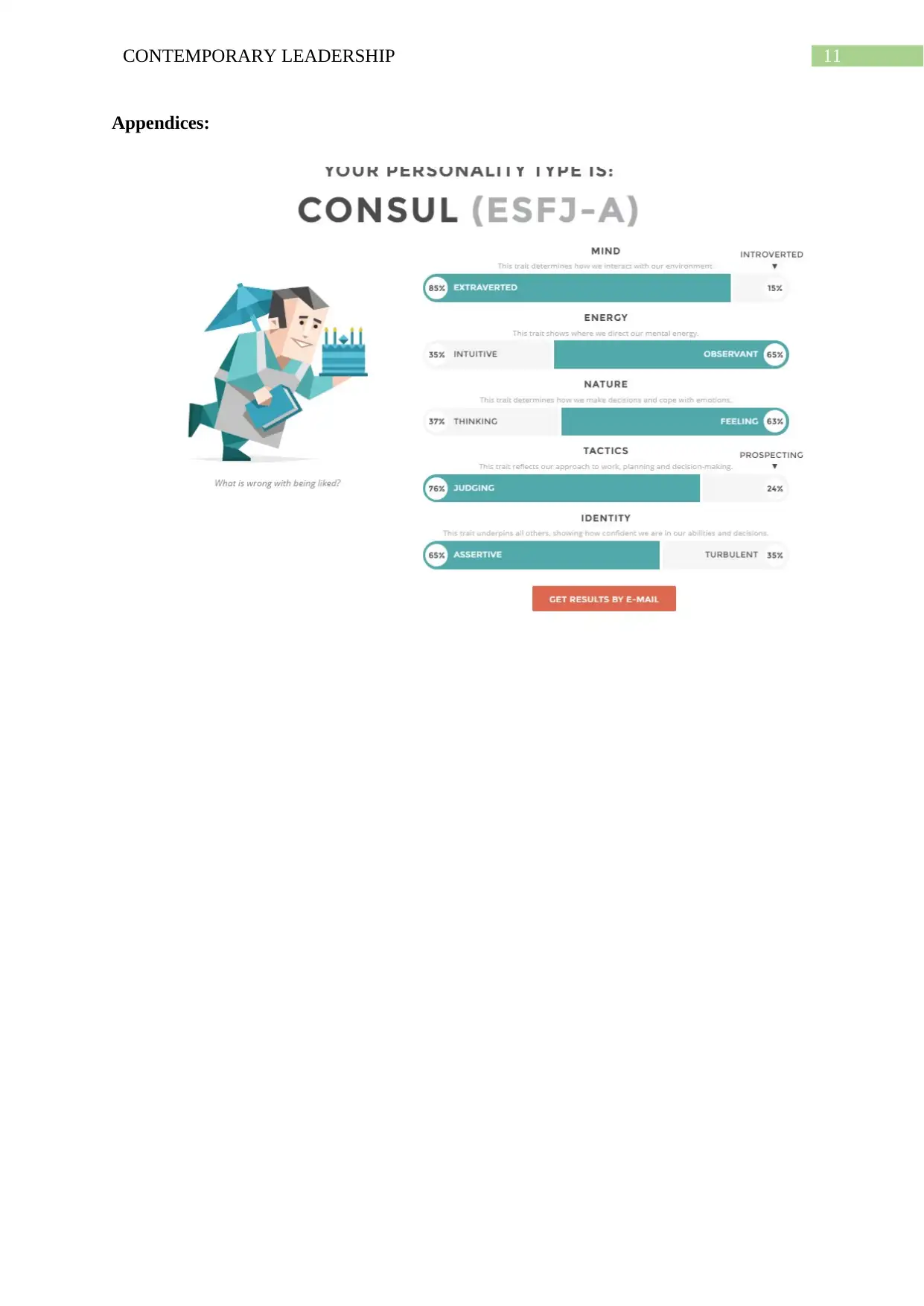
11CONTEMPORARY LEADERSHIP
Appendices:
Appendices:
⊘ This is a preview!⊘
Do you want full access?
Subscribe today to unlock all pages.

Trusted by 1+ million students worldwide
1 out of 12
Related Documents
Your All-in-One AI-Powered Toolkit for Academic Success.
+13062052269
info@desklib.com
Available 24*7 on WhatsApp / Email
![[object Object]](/_next/static/media/star-bottom.7253800d.svg)
Unlock your academic potential
Copyright © 2020–2025 A2Z Services. All Rights Reserved. Developed and managed by ZUCOL.





